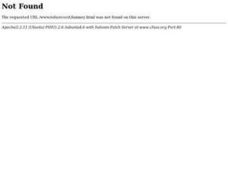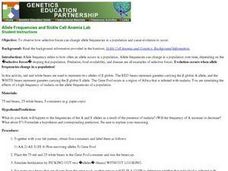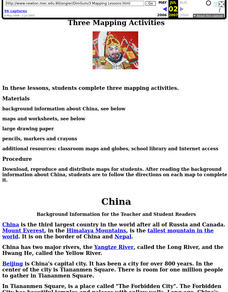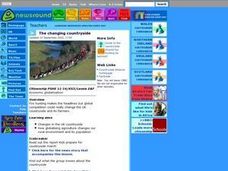Curated OER
Introduction to Worm Bin Project
Students observe the decomposing process of the food chain in a worm bin. They observe whether the type of food fed to worms affect the castings given off during the decomposition process. They learn and practice graphing their findings.
Curated OER
Going On A Picnic
Students classify items you would bring on a picnic into different categories. In this sorting lesson plan, students have categories of food, table things, and toys. A simple lesson that teaches an important skill.
Curated OER
SNACK SACK
The student will experience the concepts of ratio and production, using agricultural products considered snack foods. 2. The student will analyze and record information from the class experience.Bring in a wide assortment of packaged...
Curated OER
Wheat: Ancient and Ageless
Students label the parts of a wheat plant on a worksheet. In this Egyptian farming lesson, students thresh a wheat stem and estimate the amount harvested. Students research Ancient Egypt online.
Curated OER
Land Use Issues
Students discover seeds are a source of life. They also label the parts of a seed and examine the conditions which are needed for the seed to start growing. They follow the life cycle of seeds.
Curated OER
Products of the Rain Forest
Seventh graders explore products of the rain forest. They consider items from their home that may have been products of the rain forest by checking ingredients on product labels. They share their discoveries in class and create a...
Curated OER
Trees
Fourth graders discuss the function of roots, trunk, crown, bark, cambium heartwood, and leaves of a tree. They create a tree diagram and label roots, trunk, crown, bark, cambium heartwood and leaves when shown a list of parts and an...
Curated OER
All Wrapped Up
Pupils work in teams to identify and sort types of packaging used in food production. They consider ways to reduce the environmental impact of packaging and reflect how consumer choices play a role in trash production.
Curated OER
Cutting Sandwiches
Students discuss shapes and their characteristics. As a class, they explore shapes made from a square. Students explore triangles, squares, fractions of a square such as a half and a quarter. Individually, they complete worksheets, and...
Curated OER
Heart Healthy
Students assess their risk of heart disease. In this adult health activity, students differentiate saturated and unsaturated fats. They discuss different heart healthy food ideas.
Curated OER
Money Skills (Using Coins)
Students pretend to purchase items at their class store using coins. At the store, they are to state the amount of the item they want to buy by reading the label. They give the cashier the correct amount of coins and are given a mark on...
Curated OER
Spring Collecting and Identifying Bumble Bees
Young scholars collect bumble bees in the field, record data, pin and label specimens, answer conclusion questions, and send specimens to research leaders for verification. They improve their ability to work in research teams. Students...
Curated OER
Observing Plants
Students identify how plants affect the survival of a caterpillar and what plants need to survive. They plant three bean seeds in the three containers, placing two containers at a sunny window and the third one in a dark closet and label...
Curated OER
Oysters: Impacts on Bay and Economy
Students are able to understand the history and economic impact of the oyster, as well as its function in the St. Mary's River Ecosystem. They are provided live specimen for each student to investigate and touch. Students are provided...
Curated OER
What's the Matter with My Orange?
Students use oranges to informally explore decomposition, dehydration, fermentation, the water cycle, bacteria, yeast, food webs, the needs of living things, and physical vs. chemical change over a period of three or more months.
Curated OER
Allele Frequencies and Sickle Cell Anemia Lab
Students investigate how selective forces like food, predation and diseases affect evolution. In this genetics lesson, students use red and white beans to simulate the effect of malaria on allele frequencies. They analyze data collected...
Curated OER
China: Dim Sum: 3 Mapping Lessons
Fourth graders, after studying maps, draw a very large outline map of Asia and then a large map of China on it in the appropriate place. They label the appropriate information.
Curated OER
A Race Against Time
Pupils explore the act of preservation first in the process of preserving food and then in the preservation of historic sites, buildings, landmarks, and artifacts.
Curated OER
What Do Plants Need to Grow?
Students in an ESL classroom identify the necessary requirements plants need to grow. Using Spanish worksheets, they label each part of a plant and state their function. They are given cutouts of a picture and the Spanish word in which...
Curated OER
The Changing countryside
Students draw a poster showing the costs and benefits of opening up Britain's farmers to the global marketplace. They use a piece of A4 or A3 paper in landscape. Students draw a vertical line to split the page in two. On the left...
Curated OER
Lead Poisoning and Ceramic Dishes
Students explore the amount of lead in ceramic plates through an experiment. Students determine if everyday dishware is leaching lead into food. They chart their results and discuss how much lead in ceramic dishware may cause lead...
Curated OER
Being Thankful
Students generate words and pictures to show their thankfulness. In this Thanksgiving art lesson, students draw various circles, labeling and illustrating the things for which they are grateful.
University of Georgia
Monohybrid Crosses and The Punnett Square Lesson Plan
Looking for a quick, hands-on activity to teach young scientists about Punnett squares through monohybrid crosses? then check out this one.
Nuffield Foundation
Investigating the Effects of Biochar on Soil Fertility
Breathe some new life into charcoal. Scholars use biochar to improve soil fertility. They test the effectiveness of this addition by conducting an experiment with soil having 0%, 2%, and 4% biochar.
Other popular searches
- Reading Food Labels
- Reading Nutrition Labels
- Nutrition Food Labels
- Interpreting Food Labels
- Read Food Labels
- Food Labels for Nutrition
- Examples of Nutrition Labels
- Meat Food Labels
- Fill Out Food Labels
- Fast Food Nutrition Labels
- Nutrition Facts Pie Graph
- Calculating Food Labels

























